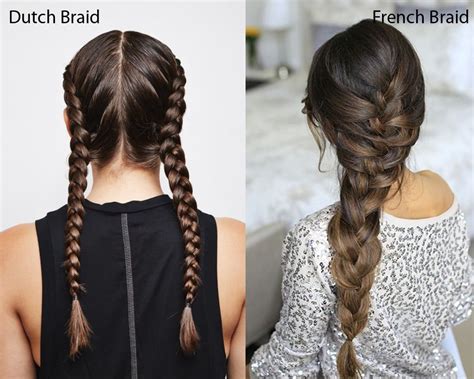When it comes to hair braiding, two timeless techniques stand out: French braiding and Dutch braiding. Both methods produce captivating and intricate designs, but they differ subtly in construction and aesthetics. This article will delve into a riveting comparison of these two braiding wonders, exploring their key differences, pros, cons, and the factors that determine the optimal choice for each occasion.

Origin and Construction
French Braid:
– Originating in France, the French braid is a classic, three-strand braid.
– It is constructed by weaving three strands of hair over and under each other, with each strand crossing the middle strand alternately.
– The braid is typically flat and rests close to the scalp, creating a sophisticated and elegant look.
Dutch Braid (Inverted French Braid):
– The Dutch braid is a reverse of the French braid, also known as an “inverted” French braid.
– It follows the same three-strand construction, but the strands are woven under and over each other, resulting in a raised braid that sits above the scalp.
– The Dutch braid creates a bolder and more voluminous effect, adding a touch of drama and texture.
Visual Appeal
French Braid:
– Characterized by its sleek and sophisticated appearance.
– Flat and subtle, it complements formal or semi-formal attire.
– Suitable for a wide range of hair textures and lengths, although it may be more challenging to achieve a French braid on shorter hair.
Dutch Braid:
– Known for its bold and voluminous appearance.
– Raised above the scalp, it adds height and drama to the hairstyle.
– Particularly flattering on thicker hair or longer hair that can support the weight of the braid.
Versatility
French Braid:
– Versatile, can be worn on its own or incorporated into updos and half-up styles.
– Creates a clean and polished look that is suitable for everyday wear or special occasions.
– Can be easily embellished with accessories like ribbons or beads.
Dutch Braid:
– More visually striking, often used as a statement piece or to add volume and texture to hair.
– Not as versatile as a French braid, as it may not blend as seamlessly into other hairstyles.
Ease of Creation
French Braid:
– Requires some skill and practice to master.
– Can be challenging to achieve a tight, even braid without any flyaways.
– More suitable for individuals with experience in hair braiding.
Dutch Braid:
– Generally considered easier to create than a French braid.
– The raised position of the braid provides more room for error.
– Suitable for beginners who may find a French braid too intricate.
Pros and Cons
| Feature | French Braid | Dutch Braid |
|---|---|---|
| Appearance | Sleek, sophisticated | Bold, voluminous |
| Versatility | Can be incorporated into other hairstyles | Statement piece |
| Ease of creation | Requires skill | Easier to create |
| Hair type | Suitable for most hair textures | Flattering on thicker, longer hair |
Factors to Consider When Choosing
The best choice between a French braid and a Dutch braid depends on the following factors:
- Desired appearance: French braids offer a sophisticated, polished look, while Dutch braids create volume and drama.
- Hair type and length: Dutch braids are ideal for thicker, longer hair, while French braids can be adapted to a wider range of textures and lengths.
- Occasion: French braids are suitable for both formal and casual settings, while Dutch braids make a statement for special occasions.
- Skill level: French braids require more skill and practice, while Dutch braids are easier for beginners.
Conclusion
French and Dutch braids are two captivating techniques that transform hair into intricate works of art. Each braid possesses unique characteristics, offering a range of styling options to suit different tastes and occasions. Understanding the differences between these two iconic braids empowers individuals to make an informed choice that aligns with their desired appearance, hair type, and skill level. Whether seeking a sleek and refined look or a bold and voluminous statement, the French vs. Dutch braid debate provides a tantalizing choice for hair stylists and enthusiasts alike.
